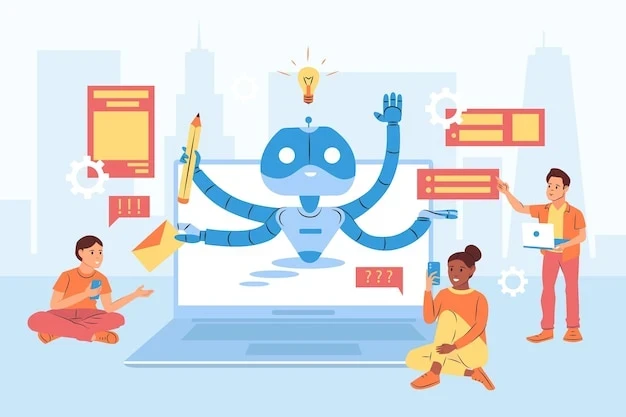The way exams are graded has remained the same for decades. Teachers spend hours reviewing multiple-choice answers, grading essays, and providing feedback. This process takes time and often leads to inconsistencies in grading. AI exam grading solutions are changing the system by providing faster, more accurate, and unbiased assessments.
Using machine learning and natural language processing (NLP), AI can grade exams, spot patterns, and score student answers with little human input. Schools, universities, and online platforms are turning to AI-powered grading to save time, cut down on mistakes, and improve learning experiences.
Let's look at how AI exam grading solutions work, what they offer teachers and educators, and what the future holds for AI in education!
How AI Is Revolutionizing Traditional Grading Methods
AI exam grading solutions are automated systems that evaluate student responses using artificial intelligence. These solutions are designed to grade multiple-choice, short-answer, and essay-based exams with accuracy and consistency.
Traditional grading relies on human evaluators, which can lead to inconsistencies, delays, and subjective bias. AI-powered grading systems are changing this by offering:
Faster grading - AI can process thousands of exams in minutes, reducing wait times for students.
More accuracy - Unlike human graders, AI does not get tired or distracted. It follows a consistent scoring method.
Unbiased assessments - AI eliminates favoritism and ensures that every student is graded by the same standards.
Instant feedback - Students receive their scores quickly, helping them learn from their mistakes.
Why Schools and Universities Are Adopting AI Grading Tools
Let’s take a look at the main reasons why more and more schools are adopting this technology.
Growing Class Sizes
Student enrollment numbers are rising globally. In many schools and universities, a single professor may handle hundreds or even thousands of students per semester. Traditional grading methods make it nearly impossible for educators to assess student work quickly while maintaining quality.
Challenges teachers face with large class sizes:
Time-consuming grading - Reviewing hundreds of assignments manually is exhausting.
Inconsistent evaluation - With so many students, grading can become less precise over time.
Delayed feedback - Students wait longer for results, which affects their learning progress.
How AI helps with growing class sizes:
Time-saving automation: Automates grading tasks, reducing hours of work to minutes.
Consistent evaluation: Maintains consistency, applying the same standards to every student.
Instant feedback: Provides instant feedback, allowing students to improve quickly.
Online Education Growth
The rise of remote learning and digital classrooms has increased the demand for automated grading solutions. Many institutions now rely on online courses, where students take exams and submit assignments remotely. Manual grading is not practical when thousands of students enroll in these courses.
Why traditional grading doesn’t work well in online education:
High workload: Professors cannot manually grade thousands of online exams.
Expectation of quick feedback: Online students expect faster feedback compared to in-person classes.
Technology requirements: Online learning platforms need seamless grading integration.
How AI helps with online education growth:
Instant grading: Grades assignments instantly after online submissions.
Performance insights: Provides detailed analytics on student performance.
Versatile assessment: Supports various question formats, including essays, coding assignments, and multiple-choice exams.
Need for Data-Driven Education
Education is shifting toward data-driven decision-making. AI-powered grading solutions do more than just assign scores—they collect valuable data that helps educators understand student learning patterns.
How student performance data benefits education:
Identifies knowledge gaps – AI detects areas where students struggle and suggests improvement strategies.
Personalizes learning – AI can tailor lessons based on each student’s strengths and weaknesses.
Improves teaching methods – Teachers can adjust their instruction based on student performance trends.
Reducing Teacher Workload
Teachers already handle lesson planning, lectures, student support, and administrative tasks. Adding grading to this workload increases stress and leaves little time for personalized instruction.
Long hours: Spending hours outside of class grading assignments
Limited student interaction: Less time for direct student engagement and mentoring
Inconsistent grading: Fatigue leading to grading inconsistencies
How AI reduces educator's workload:
More student focus: Reduces time spent grading, allowing teachers to focus on students.
Less repetitive work: Handles repetitive grading tasks, freeing up energy for lesson planning.
Hybrid grading support: Supports hybrid grading models, where AI grades objective answers while teachers review critical thinking responses.
How AI Exam Grading Process Works
AI uses algorithms and natural language processing (NLP) to assess written responses, making sure the grading is fair and unbiased.
AI grading systems use a clear process to assess student responses quickly and accurately. While the steps may differ depending on the platform and subject, most AI grading solutions follow four main steps. Let's take a closer look.
Scanning and Data Input
AI grading solutions start by scanning and analyzing student answers from digital submissions or scanned handwritten papers. It uses optical character recognition (OCR) to read text, even when the handwriting is not standard. Once scanned, the system organizes answers based on the exam format, whether multiple-choice, short answer, essay, or code submission.
Understanding and Evaluating Responses
For multiple-choice questions, AI quickly checks responses against stored correct answers. For short-answer and essay questions, it uses natural language processing (NLP) to understand meaning, grammar, and structure. When grading programming assignments, the AI runs the submitted code, checks if it works correctly, and evaluates its efficiency.
Assigning Scores Based on Predefined Criteria
The system assigns scores based on predefined criteria. It compares student responses with grading rubrics and high-quality sample answers. Machine learning models analyze past grading patterns to keep scores consistent. AI also provides a confidence score, showing how certain it is about the assigned grade.
Providing Feedback and Reports
In addition to grading, AI provides feedback and reports. It highlights mistakes, strengths, and areas where students can improve. Students receive personalized suggestions to help them refine their understanding. Teachers also get performance analytics, allowing them to adjust their instruction based on student needs.
How Teachers and Educators Can Use AI Grading Ethically
For AI exam grading solutions to work well for both students and teachers, they need to be used in a way that keeps things fair, accurate, and includes checks from humans.
Here are some important things to think about and best practices for using AI in grading responsibly.
Maintaining Transparency in AI Grading
Students and parents often express concerns about how AI assigns scores, especially in subjective subjects like essays and creative writing. When an AI grading system makes a decision, students should understand why they received a specific score and have an opportunity to challenge it.
How teachers can maintain transparency:
Explain AI grading: Clearly explain how AI grading works before students take an AI-graded exam.
Provide detailed feedback: Offer AI-generated feedback to help students understand their mistakes.
Allow manual reviews: Let students request a manual review if they believe their score is incorrect.
Encourage open discussions: Build student trust by discussing AI’s role in grading.
Reducing Bias in AI Grading Systems
AI models are trained on past data, which means they can inherit biases from previous grading patterns. If an AI system is trained on biased data, it may unfairly favor certain writing styles, perspectives, or even specific demographic groups.
How educators can reduce AI grading bias:
Audit AI grading: Regularly review AI grading results to check for potential biases.
Use diverse data: Train AI on varied data to prevent it from favoring specific answers.
Blend AI with human review: Combine AI with human grading for complex or subjective assessments.
Monitor scoring trends: Track AI grading patterns to ensure fair treatment of all students.
Balancing AI Automation with Human Judgment
AI grading should not completely replace human graders, especially in areas that require deep understanding, critical thinking, or creativity.
While AI is excellent at grading structured responses (such as multiple-choice questions and formula-based math problems), human teachers are better at evaluating nuanced responses, creative arguments, and ethical reasoning.
How teachers can balance AI and human grading:
AI for objective tasks: Use AI for grading multiple-choice and coding assessments.
Human review for subjectivity: Manually grade essays and responses that require deeper interpretation.
Teacher overrides: Allow educators to adjust AI scores when necessary.
AI-assisted grading: Use AI as a support tool rather than fully automating grading in discussion-based subjects.
Join the Future of Education with ExamAI

Teaching is hard enough—grading shouldn’t be. ExamAI revolutionizes the way educators create, administer, and grade exams, saving time and improving the learning experience for both professors and students.
Create Exams in Minutes
No more tedious exam preparation. With ExamAI, you can create exams manually or use AI to generate them from class notes, past exams, and general knowledge. Multiple-choice, short answers, and open-ended questions—everything is covered.
Grade Exams Instantly with AI
Save hours of grading time with AI-powered assessment. Whether exams are taken on our platform or handwritten and scanned, ExamAI's auto grading feature accurately grades responses, reducing bias and effort while keeping assessments fair.
Provide Instant Feedback for Students
Every exam becomes a learning experience. AI-generated feedback on every question helps students understand mistakes and improve faster, instead of just receiving a score.
Export Grades Seamlessly
No more manual data entry. ExamAI allows professors to export grades directly to Canvas, with Blackboard integration coming soon, making grade management effortless.
Track Class Performance with Analytics
Get valuable insights into student performance with our Analytics Portal. Identify trends, spot knowledge gaps, and improve teaching strategies based on real data.
Sign up today and experience the next generation of education technology!
FAQs About AI Exam Grading Solutions
Is there an AI that can grade papers?
Yes, there are AI grading tools that can help with the grading process. These tools use AI grading systems to automatically grade student assessments, including essays, short answers, and even coding assignments. While they work well for grading structured responses like multiple-choice tests, they can also analyze student responses in essays based on grading rubrics and grading criteria.
Can AI be used for grading?
Yes, AI can be used for grading. Many schools and teachers use AI grading tools to improve grading efficiency and save time. These tools help grade student assignment submissions quickly, especially for objective questions. Some AI tools also analyze writing and provide personalized feedback, but human oversight is still important to make sure the feedback is accurate and fair.
Can AI grade my work?
Yes, teachers can use an AI grader to automatically grade student assessments, especially if the work involves multiple-choice tests or structured answers. For essays and open-ended responses, AI can analyze student performance, check for grammar, and offer constructive feedback based on grading rubrics. However, for complex assignments that need deep understanding and creativity, human grading is still more reliable.
Is AI good at grading essays?
AI is much more reliable when used to grade multiple-choice tests, and it is getting better at grading essays, but it’s not perfect. It can assess grammar, structure, and coherence while offering meaningful feedback based on grading criteria. Some AI tools can provide personalized feedback and even detailed feedback on writing style and argument clarity. However, AI still struggles with context, creativity, and deep analysis, so human grading is often needed for final evaluations.



